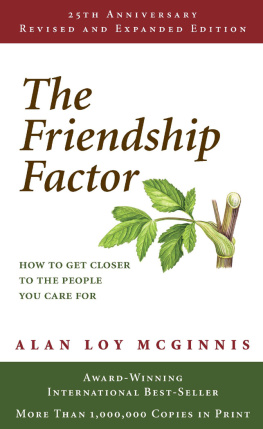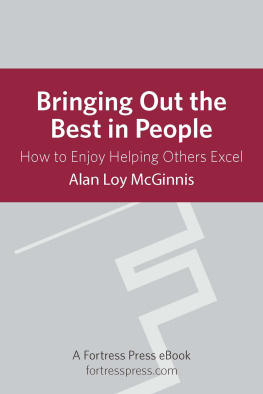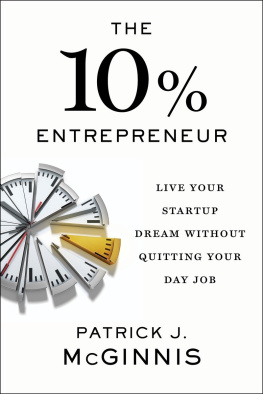
The
Friendship
Factor

HOW TO GET CLOSER
TO THE PEOPLE
YOU CARE FOR
ALAN LOY MCGINNIS

Also by Dr. Alan Loy McGinnis
The Romance Factor (New York: HarperColins, 1982, distributed by Dickinson Publishing Group, Seattle and Glendale)
Bringing Out the Best in People (Minneapolis: Augsburg, 1985)
Confidence (Minneapolis: Augsburg, 1987)
The Power of Optimism (New York: HarperColins, 1990, distributed by Dickinson Publishing Group, Seattle and Glendale)
The Balanced Life (Minneapolis: Augsburg, 1995, distributed by Dickinson Publishing Group, Seattle and Glendale)
Editions of The Friendship Factor have been published by Claretian (Philippines), Glad Sounds (Malaysia and Singapore), Hodder and Stoughton (U.K.), Lutheran Publishing House (Australia and New Zealand), St. Pauls (India, Pakistan, Sri Lanka).
The book has also been translated into Afrikaans, Chinese, Dutch, Finnish, French, German, Hindi, Indonesian, Japanese, Korean, Norwegian, Polish, Portuguese, Romanian, Russian, Slovak, Spanish, Swedish, and Thai.
For books and audiocassettes by Dr. McGinnis, or to inquire about Dr. McGinniss availability for seminars, write or call Dickinson Publishing Group, 1110 Catalina Drive, Glendale, California, 91207, 818-247-7496, .
THE FRIENDSHIP FACTOR
How to Get Closer to the People You Care For
Copyright 1979, 2004 Augsburg Fortress Publishers. All rights reserved. Except for brief quotations in critical articles or reviews, no part of this book may be reproduced in any manner without prior written permission from the publisher. Write to: Permissions, Augsburg Fortress, Box 1209, Minneapolis, MN 55440.
Large-quantity purchases or custom editions of this book are available at a discount from the publisher. For more information, contact the sales department at Augsburg Fortress, Publishers, 1-800-328-4648, or write to: Sales Director, Augsburg Fortress, Publishers, P.O. Box 1209, Minneapolis, MN 55440-1209.
Scripture passages are from the New Revised Standard Version of the Bible, copyright 1946, 1952, 1971, 1989 by the Division of Christian Education of the National Council of the Churches of Christ in the USA. Used by permission.
Scripture passages are from the Good News BibleOld Testament: copyright 1976 American Bible Society; New Testament: copyright 1966, 1971, 1976 by the American Bible Society. Used by permission.
Scripture passages are from the New American Standard Bible, copyright 1960, 1962, 1963, 1968, 1971, 1972, 1973, 1975, 1977 The Lockman Foundation. Used by permission.
Scripture passages are from the New American Bible, copyright 1970 by the Confraternity of Christian Doctrine, Washington, DC, and are used by permission of the copyright owner. All rights reserved.
ISBN 0-8066-3571-1
Cover and book design by Michelle L. N. Cook, cover art from Artville.
eISBN 9781451403527
Contents


W HEN D IANE AND I FOUND AN ADVANCE COPY of The Friendship Factor on our doorstep twenty-five years ago, we ripped open the package. We held the book at arms length to look at the cover together. We fondled it, thumbed through it, turned it over and over, made certain there was print inside, pulled it to our noses to take in the fragrance of the new binding. Then we looked up and down the street to see if some neighbors might be outside to whom we could show the book.
How many copies would it have to sell for you to consider it a success? Diane asked.
Dunno. Never thought about it.
Well think about it. For fun, pick a number.
I had heard somewhere that publishers break even on a book at about ten thousand copies. I was grateful to Augsburg for gambling on an unknown and unpublished writer, and didnt want them to lose money. So I said, Honey, if it sold ten thousand copies Id be so happy.
Think it will?
Cant see how.
Now, twenty-five years later, without appearing on most best-seller lists, The Friendship Factor has sold close to two million copies, been translated into about twenty languages, and has continued to sell steadily year after year. Crazy things happen.
The publisher has asked me to comment on how one can account for this widespread distribution. I hesitate to offer opinions. I certainly am not under any illusion that the book is the psychological masterpiece of our time.
However, I do have some ideas on why the topic has had a broad appeal. One of the assumptions of the book is that friendship is the learning ground for all other relationships. If we can learn to be skilled at friendship, we will also be good at attracting the opposite sex, building efficient teams at work, getting along with our parents, rearing our children, and staying tight with our mates.
Second, this is the only book on this topicas far as I knowto use Jesus as the model for learning to love. While doing the original research, I read the New Testament several times (and have done so once again while doing this revision), trying to understand the principles and techniques Jesus demonstrated in each of his encounters with people.
How is it that this has become a best-seller in such diverse places as Poland, Sweden, Mexico, South Africa, Japan, Korea, and Slovakia? Thats easy. Love is a world-wide, cross-cultural, bridge building phenomenon. Although we may express our affection in different ways (an appropriate statement of tenderness between friends in Italy, might be offensive in Sweden), and although our cultures will cause different difficulties in connecting, we all long to love and be loved.
In my work as a psychotherapist during these ensuing years, I have become more convinced than ever that a restoring and renewing power resides in friendship. If people availed themselves of the love available to them, many therapists like me could close up shop.
While teaching my clients how to improve their connections with people, I have also become more and more convinced that anyoneno matter how introverted, no matter how bungling in previous friendshipscan learn the skills of love. It only requires the resolution to do so, plus a willingness to learn the principles that great friends and lovers have used for thousands of years.
This conviction has come not only from my work but also from my life. The power of love has almost overwhelmed me at times as I have continued to rub shoulders with the friends named in the first editionmost of all with Diane. But also with my children (now all adults), and with people such as Dr. Taz Kinney, Dr. John Todd, Dr. Neil Warren, and, until his death, Mr. Mark Svensson. (When Mark died at age eighty the two of us had by then been meeting for lunch at least once a week for thirty years.) Whats more, in these twenty-five years a new crowd has decided to join our family. Christopher, Tyler, Avery, and Hope have brought the kind of laughter and love into their grandparents home that only infants and little children provide. With such people I have done more than observe the power of friendshipI have felt it.
Next page













